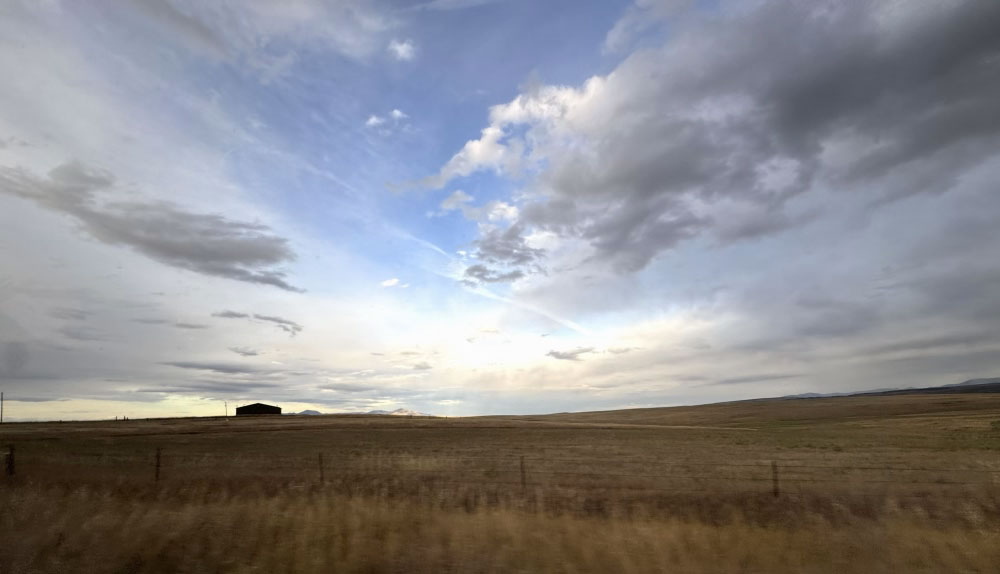
A view of Montana’s legendary big sky just outside Great Falls, Montana.
Photo by Kelly Barraza.
There is no shortage of drive and entrepreneurial spirit in Big Sky Country.
From the moment my flight touched down at Great Falls International Airport in early October, signs of the area’s economic, geographic and cultural identity began to appear.
One of the first things I spied from the airplane window was a U.S. Air Force plane, later identified as a Lockheed C-130 Hercules. The Montana Air National Guard and Malmstrom Air Force Base are both located in Great Falls. The Air Guard’s mission includes tactical airlift, firefighting and search and rescue operations. The U.S. Air Force will be modernizing its aging nuclear missile system at Malmstrom Air Force Base (on the other side of the Missouri River from the airport). The Malmstrom AFB Sentinel Missile Upgrade program will see an estimated $1.5–2 billion in direct spending in Montana for construction, infrastructure, housing and support facilities. Malmstrom AFB manages over 150 missile silos across north-central Montana. The project is expected to spur more than 3,000 construction jobs and over 500 long-term support and maintenance positions.
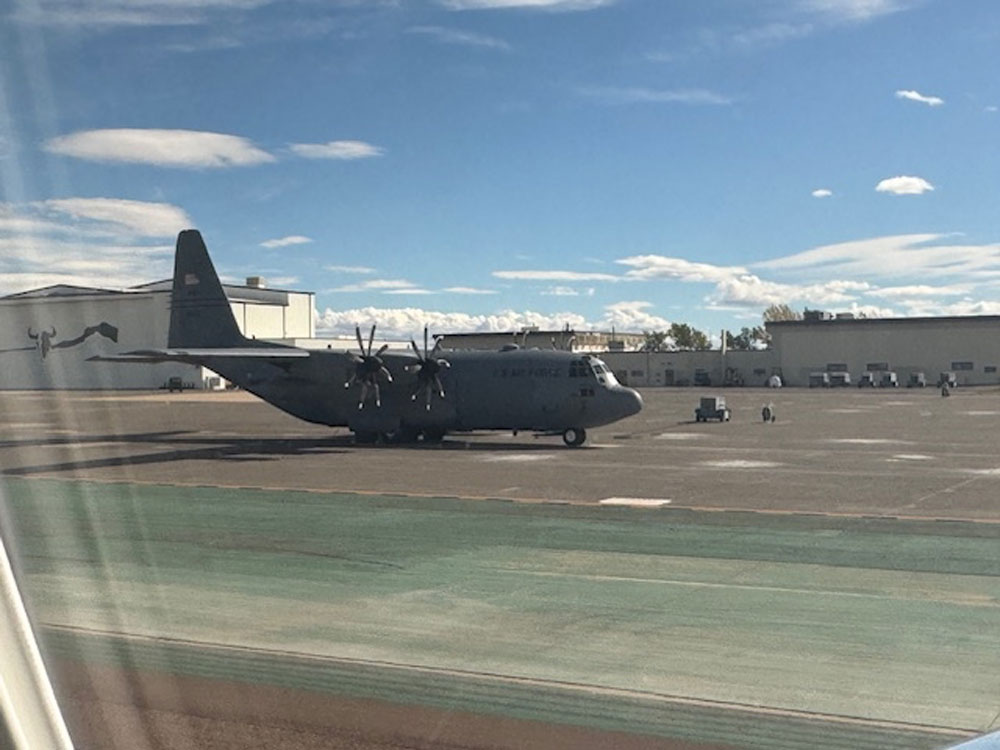
The Montana Air National Guard and the Malmstrom Air Force Base are both located in Great Falls.
Photo by Kelly Barraza.
Leaving the airport to catch my cab to the city, a gust of wind almost immediately snatched away the Zoo Atlanta baseball cap I was wearing to shield my eyes and airport hair. This proved to be an excellent aerometric marker for the abundant wind energy resources in the region, harvested via wind turbines that pepper the Great Falls landscape.
Welcome to the Electric City
And what a landscape it is: The Little Belt Mountains, Square Butte and the Rockies color the surrounding horizon of Great Falls, which at 60,000 residents is the third most populated city in the state after Billings and Missoula. Running through the city’s center is the Missouri River, which I walked alongside the next day with Jake Clark, vice president of business development at Great Falls Development Alliance. He told me about the moves being made to build out the local energy infrastructure.
“Great Falls has a really long history with energy,” Clark said, noting the several hydroelectric dams in the city that once powered copper production in the city. The Anaconda Copper Mining Company was the copper smelting and refining complex, in operation for about 100 years until its closure in 1980, that put Great Falls on the map. A power-intensive project that exemplified one of the first commercial uses of hydroelectric power, the refinery also smelted copper that would eventually be used in the early days of electrification across the country.

Great Falls is home to five waterfalls, four of which have been dammed. Black Eagle Falls was the first to have a dam, initially a timber-and-rock crib structure build in 1890 and replaced by a concrete one in the late 1920s. It was the first hydroelectric dam built in Montana and the first on the Missouri River.
Photo by Kelly Barraza.
And the region continues to see big wins in energy and fuel.
“Our refinery cracked the code on sustainable aviation fuel,” says Clark about the Calumet Montana Refining facility. Great Falls is also home to Montana Renewables, the largest producer of sustainable aviation fuel (SAF) in North America. “And there’s a couple-billion-dollar upgrade ongoing right now to stay on the top of that hill,” Clark says of the $1.67 billion expansion at Montana Renewables supported by a U.S. Department of Energy loan guarantee, the largest clean energy investment in Montana. “So, they’ll be doing significantly more.”
Green hydrogen is also on the table for the Calumet refinery and at Montana Renewables. Most green fuels produced at the facilities are shipped to California, where state tax credits help incentivize that portion of the energy supply chain. “It’s farm-to-table jet fuel,” Clark says about the whole operation. “In addition to what is going on at our refinery now, Berkshire Hathaway Energy recently purchased what’s called the Montana Alberta Tie Line. If you go north of Great Falls, you see large wind farms. Those wind farms feed that line, and Berkshire Hathaway Energy purchased that in order to develop more energy business on the U.S. side of that line … We see the potential for a data center cluster between here and the Canadian border in our region to do several other data centers because we have more independent power generation than any other part of the state as well as the potential to develop some behind-the-meter additional assets. And we have enough acreage for supersites.”
A 600-MW hyperscale data center coming to the Great Falls area from Atlanta-based TAC Data Centers will span 569 acres and include 2 million sq. ft. under roof. The data center, dubbed Project Cardinal, is planned for an area near the AgriTech Park, north of Malstrom Air Force Base and near the Great Falls Rainbow Power Substation, with construction of the whole campus expected to be completed by 2030. Power capacity will be between 500 and 600 MW across several buildings, supported by two on-site substations. TAC is reported to be investing between $1 billion and $1.5 billion in the facility, which is projected to create 1,500 to 2,000 construction jobs and 150 to 200 high-paying permanent positions.
“We have the fiber,” Clark says about Great Falls’ potential for advanced digital infrastructure. “We have the water. We have the land. And we’re working on talent.”
Berkshire Hathaway Energy Montana will add a 72-MW battery system near Cut Bank (less than two hours from Great Falls), a 100-MW solar farm on about 1,000 acres in north-central Montana (expected to be complete in 2026) and a new Great Falls control center to complement the existing wind farms attached to the Montana Alberta Tie Line (MATL) connecting southern Alberta to Great Falls.
Always Improving
Since 2020, the city of Great Falls has experienced more economic activity, major investments and population growth than it’s seen in 40 years. Stability and affordability make the city a prime location for business, says Jolene Schalper, executive vice president at Great Falls Development Alliance.
“Great Falls, Montana, makes operations affordable,” Schalper says. “We have a long history of low taxes and stable governance. We seek out tools to aid our industries and are able to work in tandem with elected officials for meaningful policy change. Our job is to listen to you and identify ways to help you thrive. Your bottom line is ours. Your team are our neighbors. The focus on long-term relationships is a key component of why Great Falls, Montana, is a great place to do business.”
In addition to the business-friendly climate that the city and state have to offer, quality of life is always improving. On the city’s east side, the mixed-use development “The Falls,” expected to launch construction in late 2026, will be a 100-acre, $500 million to $700 million project featuring retail, hotel, homes, restaurants, trails and public spaces with the goal of becoming a shopping and living hub over the next two decades. Led by Mitchell Development & Investments, the project will measure 630,000 sq. ft. and host two hotels, 831 residential units and 20 acres of public space.

“Great Falls, Montana, makes operations affordable. We have a long history of low taxes and stable governance.”
– Jolene Schalper, Executive Vice President, Great Falls Development Alliance
The area’s quality of life can also be measured by a long list of recreation, cultural and hospitality assets, including River’s Edge Trail, an urban trail system where I took an e-bike tour. The trail features nearly 60 miles of pathways (21 of them paved) and strings together several parks, sculptures and gazebos, connecting to the Lewis & Clark Interpretive Center, the Great Falls Civic Center, Riverside Railyard Skate Park, West Bank Park and Giant Springs State Park.
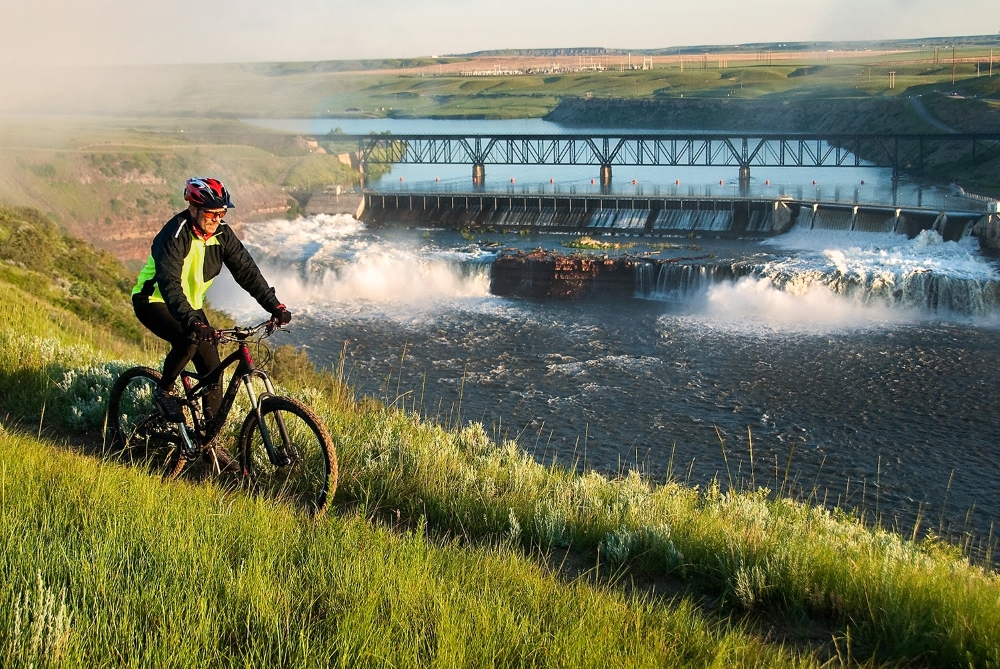
The River’s Edge trail is perfect for cyclists, hikers and families looking to spend time in the beautiful Montana outdoors.
Photo courtesy of Great Falls Montana Tourism.
The Missouri River also supplies an abundance of fish for anglers. Walleye, northern pike, sunfish, crappies, bass, catfish can all be found in the river waters running through Great Falls. Blue ribbon trout fishing off the Missouri is also seen south of the city, and salmon has been known to also populate the river. This veritable haul lends itself to a strong local fishing economy which in 2024 contributed $910 million to Montana’s GDP, according to an August 2025 report by the Bureau of Business and Economic Research.
In downtown Great Falls, restaurant and bar Enbär, live music venue The Newberry, arcade bar Sidequest and ice cream shop Big Dipper form a thread of lively options all owned and operated by a local group of investors and entrepreneurs (Enbar Inc.) who also own the minor league baseball team, the Great Falls Voyagers.

Enbär Craft Cocktail Lounge was the first of several new businesses developed and owned by Enbar Inc., which started in late 2017.
Photo courtesy of Great Falls Montana Tourism.
A local family of entrepreneurs, the Tronsons, operate the successful 5th & Wine wine bar and restaurant, headed by patriarch Mark Tronson, as well as Buffalo Blanc, a local café & coffee bar run by daughter Whitney Sunwall. Soon, the Tronson family will also add a sister wine & beer bar, Buffalo Noir, to their portfolio in Great Falls, which will be run by another Tronson daughter, Tara.
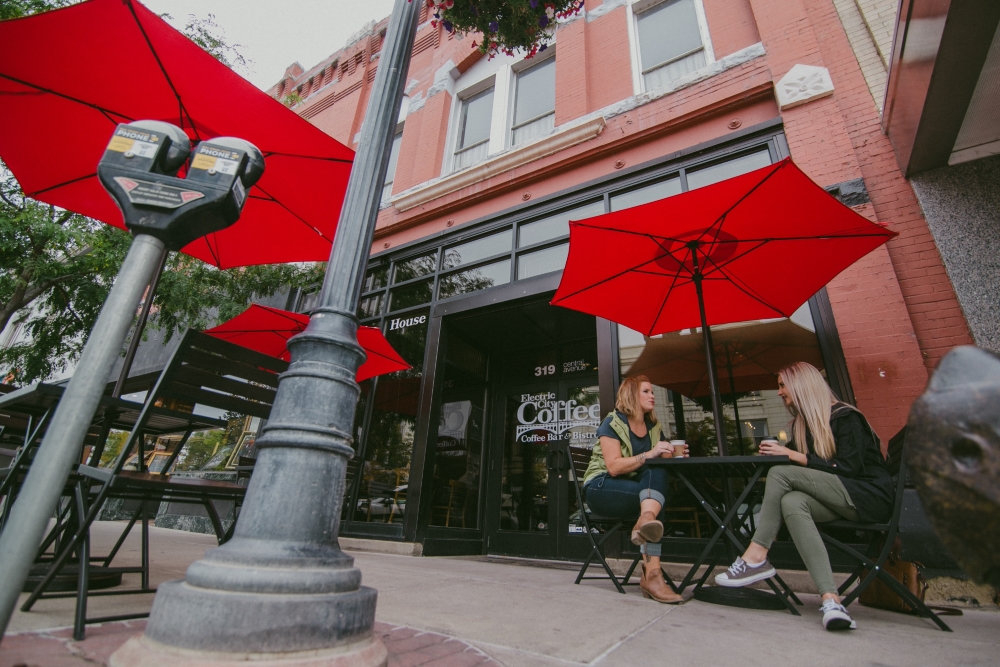
Electric City Coffee, located on Central Avenue in Great Falls, is owned by U.S. Air Force veterans and married couple Heidi and Thad Reiste.
Photo courtesy of Great Falls Montana Tourism.
Other stops in the city that will delight include independent bookstore Cassiopeia Books (owned and operated by retired Brooklyn attorney Millie Whalen), Central Avenue Meats owned by head butcher Drew Hicks that sources beef and pork locally from McCafferty Ranch and Faltree Farms, respectively, and The Farmer’s Daughter Fibers, a nationally known yarn and fabric shop run by Candice English.
Visitors seeking an experience that reaches back to an earlier time will love the Sip ‘n Dip Lounge, in operation since 1962. The tiki bar, located in the historic O’Haire Inn downtown, features “mermaids” who swim up and greet patrons in an aquarium-like window view (sadly closed during my visit), kooky and vibrant tropical-themed art, a 64-ounce cocktail (the “fishbowl”) and a jazzy live musical performer.
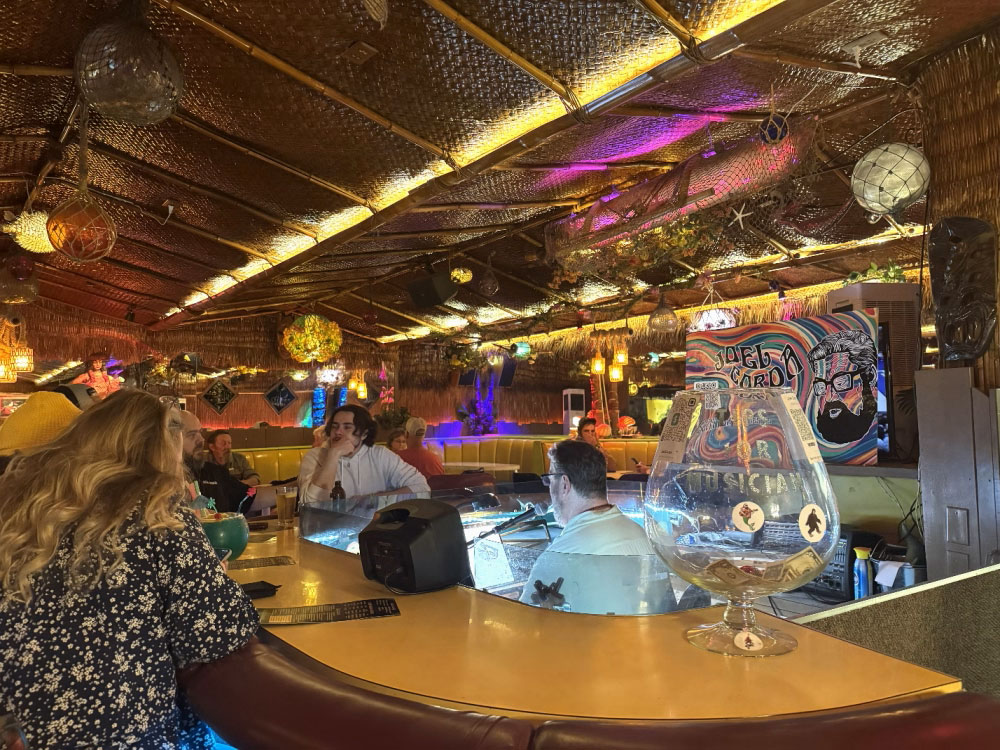
Patricia Yvonne “Piano Pat” Sponheim originally sang and played piano at Sip n’ Dip four nights a week for over 50 years, retiring at age 86 in February 2020. In 2021, local choir director, teacher and entertainer Joel Corda was selected in a competition to replace Piano Pat at Sip n’ Dip.
Photo by Kelly Barraza.
Healthy Environment for Growth
The local hospital system in Great Falls, Benefis Health Systems, will be expanding its facilities with several new and upgraded services to better serve the health care needs of the community. Construction is currently underway on a Healthy Aging Center, a 15,000-sq.-ft. outpatient clinic expected to open in 2026 that will provide audiology, mobility and geriatric services. The Sanavita Estates Senior Living development will span nearly 43 acres with a 64-unit apartment building and 28 villas for 55+ individuals and provide quality-of-life amenities such as a wine bar, ice cream parlor and a wellness center. Benefis Health Systems also recently saw an expansion of its endoscopy lab, adding rooms and bays and cutting wait times, and a renovation of its Sletten Cancer Institute that will improve patient comfort with additional infusion chairs, private treatment rooms and larger lab and pharmacy space. A new walk-in urgent care clinic with on-site pharmacy, lab, imaging and occupational health services is also expected to open in late 2025.
In 2023, a new extension campus of Touro University, a Harlem-based private medical school system in New York City, opened in Great Falls — the Touro College of Osteopathic Medicine (TouroCOM). The 100,000-sq.-ft. medical school campus houses classrooms, an anatomy lab, a simulation center and more. Three students who will be part of the first group of medical school graduates to complete their education at TouroCOM told me the biggest draws of the school were its focus on providing care for those who need it most and its welcoming environment.

Jireh Gerry, Sriteja Kankanala and Shantell Angarita (l. to r.) are all second-year medical students at Touro College of Osteopathic Medicine in Great Falls, Montana.
Photo by Kelly Barraza.
“I chose Touro because I wanted to explore a new state and environment that is different, coming from big cities,” says Shantell Angarita, who hopes to complete her residency in emergency medicine. “I was drawn toward the philosophy that Touro supports in serving patients in underserved areas.”
For Jireh Gerry, Touro was a perfect match for her goals of becoming an OB-GYN and also serving those same underserved populations.
“I chose Touro because the environment was so friendly and so refreshing from what I was used to in Los Angeles,” she says. “Additionally, the program at Touro truly helps equip student doctors to be able to serve underserved communities, which is my goal when I become a physician.”
Touro is a Jewish university system with several locations globally. Notably, the campus in Great Falls demonstrates respect for religions and walks of life from all over, providing kosher and halal cafeteria options and ways to learn and practice medicine for learners who come from different cultural backgrounds, such as providing simulation and computer-aided training for students who are not allowed to dissect cadavers due to spiritual beliefs.
The program at TouroCOM in Great Falls is expected to graduate 135 physicians each year.
Cowboys & Artists
Great Falls has a storied history of great art, dating back to the late 1800s and famed American artist of the American West Charles Marion Russell, who was one of the highest paid artists in the U.S. by the 1920s (largely helped by the business management acumen of his wife, Nancy Cooper Russell). Raised in Missouri, Russell moved to Montana at age 16 to work on ranches and lived there the rest of his life, eventually becoming a self-taught, full-time and prolific creator of Western works.
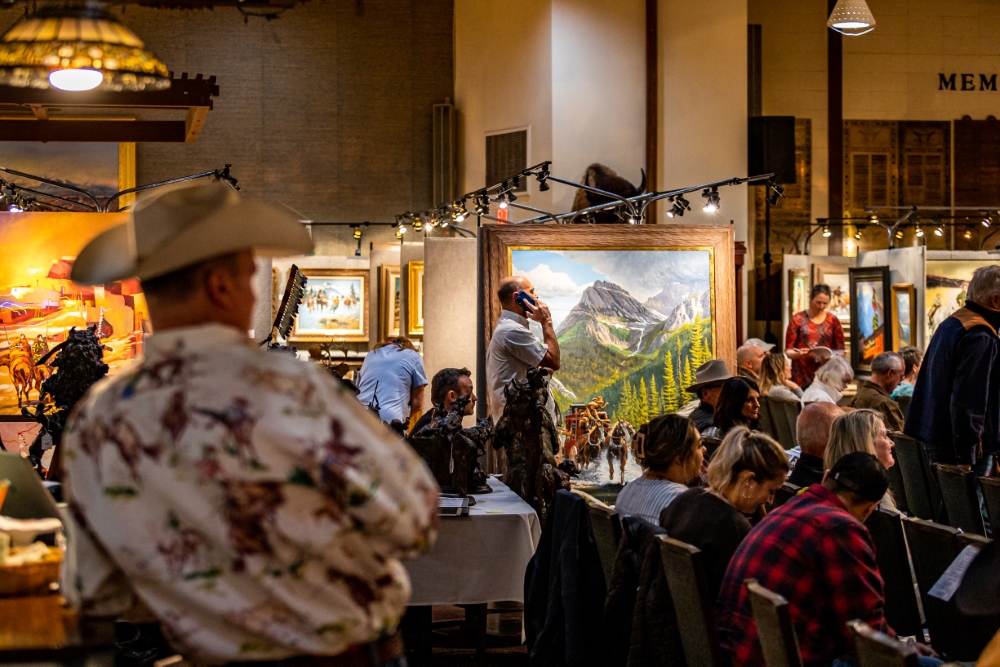

Western Art Week in Great Falls includes the Russell auction, developed out of an idea from legendary Montana broadcaster Norma Ashby (who turns 90 at the end of this year). The first auction was in 1969 at the Rainbow Hotel ballroom and $26,000 was raised.
Photos courtesy of Great Falls Montana Tourism.
Every year, the week of March 19 (Russell’s birthday) is marked by Western Art Week in Great Falls. Millions of dollars in fine art are exhibited and sold at this event held at different locations in Great Falls, culminating in the Russell Auction — the hallmark fine art fundraising event held at the C.M. Russell Museum.

A work of art by Tom Gilleon, a member of the Russell Skull Society, in his Great Falls studio. Gilleon’s journey as an artist began as an illustrator and artist for Disney’s Epcot Imagineers when he lived in Florida early in his career.
Photo by Kelly Barraza.
The Russell Skull Society of Artists, founded in 2013 by the C.M. Russell Museum to recognize living American Western artists, includes over 20 accomplished members who are involved in the Russell Auction and whose work is imbued by the tradition of C.M. Russell.
“It’s very hard to explain the experience of Western Art Week,” says Rebecca Engum, executive director of Great Falls Montana Tourism. “The town is full of art in the broadest sense of the word: creative food, unique drinks, live music, fashion shows, quick draws, auctions and art spanning every medium across 10 locations through the entire town for five straight days where every minute can be filled with something new and different. With over 800 artists on display, Great Falls is the Western Art Capital of the world, curating a bucket list event for anyone who wants to experience world-class talent.”
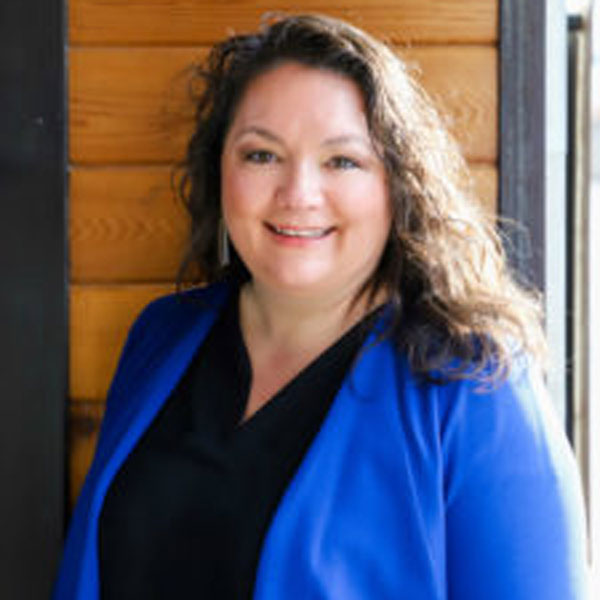
Rebecca Engum, executive director of Great Falls Montana Tourism
